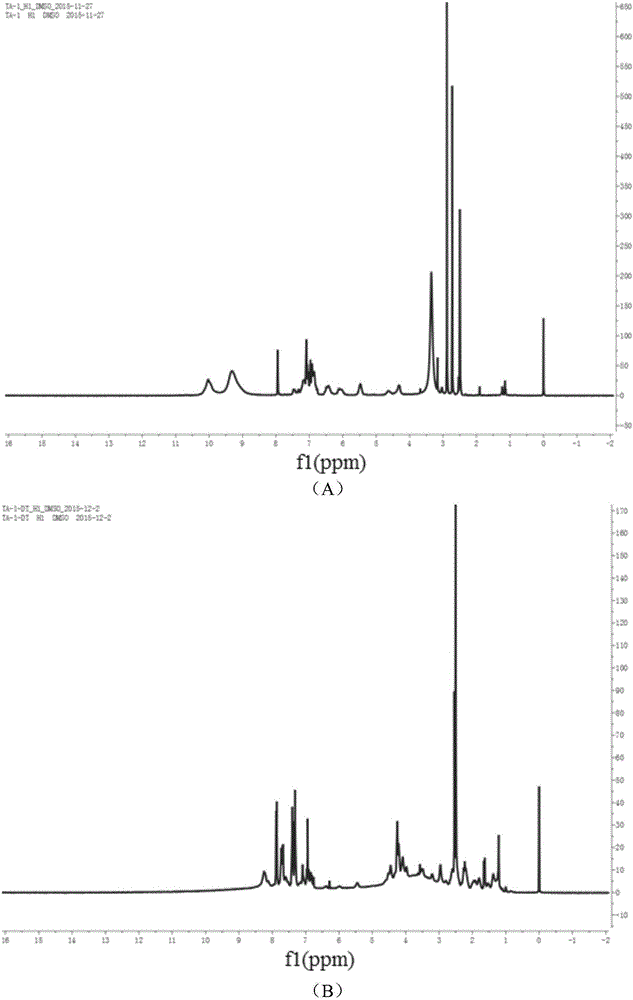Polypeptide modified tannic acid and preparation method and application thereof
A technology of polypeptide modification and tannin, which is applied in the field of polypeptide-modified tannin and its preparation, can solve the problems of difficult to repair with enamel, low content, poor effect, etc., and achieve the promotion of enamel remineralization and firmness Adsorption effect, effect of enriching types
- Summary
- Abstract
- Description
- Claims
- Application Information
AI Technical Summary
Problems solved by technology
Method used
Image
Examples
Embodiment 1
[0062] In this embodiment, a preparation method of polypeptide chain modified tannic acid is provided, and its synthetic route is as follows: figure 1 As shown, the steps are as follows:
[0063] (1) Synthesis of acryloyl-modified tannic acid
[0064] ① Prepare the first solution
[0065] Dissolve 4 g of tannic acid in 100 mL of anhydrous dimethylformamide at room temperature and normal pressure to form the first solution, and the concentration of tannic acid in the first solution is 0.04 g / mL;
[0066] ② Prepare the second solution
[0067] Under room temperature, normal pressure condition, triethylamine (TEA) is dissolved in the first kind of solution to form the second kind of solution, and the mol ratio of described triethylamine and tannic acid in the first kind of solution is 1:1;
[0068] ③Synthesis
[0069] Add acryloyl chloride (Acryloyl chloride) dropwise to the second solution under the condition of ice-water bath and argon protection at 0-5°C, react at room tem...
Embodiment 2
[0085] In this embodiment, a method for preparing two polypeptide chain modified tannic acid is provided, the steps are as follows:
[0086] (1) Synthesis of acryloyl-modified tannic acid
[0087] ① Prepare the first solution
[0088] Dissolve 5 g of tannic acid in 100 mL of anhydrous dimethylformamide at room temperature and normal pressure to form the first solution, and the concentration of tannic acid in the first solution is 0.05 g / mL;
[0089] ② Prepare the second solution
[0090] Under room temperature, normal pressure condition, triethylamine is dissolved in the first kind of solution to form the second kind of solution, and the mol ratio of described triethylamine and tannic acid in the first kind of solution is 2.1:1;
[0091] ③Synthesis
[0092]Add acryloyl chloride dropwise to the second solution under the condition of ice-water bath and argon protection at 0-5°C, react at room temperature and normal pressure for 24 hours, and then use deionized water with a mo...
Embodiment 3
[0107] In this example, a method for preparing tannic acid modified by three polypeptide chains is provided, the steps are as follows:
[0108] (1) Synthesis of acryloyl-modified tannic acid
[0109] ① Prepare the first solution
[0110] Dissolve 4.5g of tannic acid in 100mL of anhydrous dimethylformamide at room temperature and normal pressure to form the first solution, and the concentration of tannic acid in the first solution is 0.045g / mL;
[0111] ② Prepare the second solution
[0112] Under room temperature, normal pressure condition, triethylamine is dissolved in the first kind of solution and forms second kind of solution, and the mol ratio of described triethylamine and tannic acid in the first kind of solution is 3.2:1;
[0113] ③Synthesis
[0114] Add acryloyl chloride dropwise to the second solution under the condition of -5~5℃ and argon protection, react at room temperature and normal pressure for 30h, and then dialyze in deionized water with a molecular weight...
PUM
| Property | Measurement | Unit |
|---|---|---|
| Saturated adsorption capacity | aaaaa | aaaaa |
| Saturated adsorption capacity | aaaaa | aaaaa |
| Saturated adsorption capacity | aaaaa | aaaaa |
Abstract
Description
Claims
Application Information
 Login to View More
Login to View More - Generate Ideas
- Intellectual Property
- Life Sciences
- Materials
- Tech Scout
- Unparalleled Data Quality
- Higher Quality Content
- 60% Fewer Hallucinations
Browse by: Latest US Patents, China's latest patents, Technical Efficacy Thesaurus, Application Domain, Technology Topic, Popular Technical Reports.
© 2025 PatSnap. All rights reserved.Legal|Privacy policy|Modern Slavery Act Transparency Statement|Sitemap|About US| Contact US: help@patsnap.com



